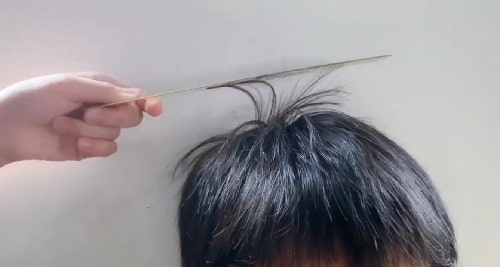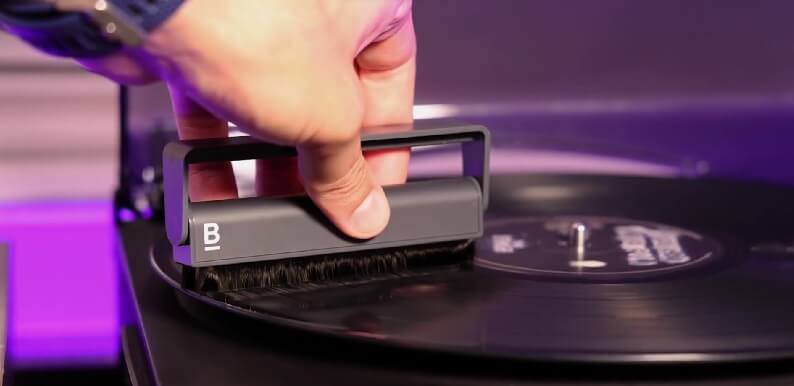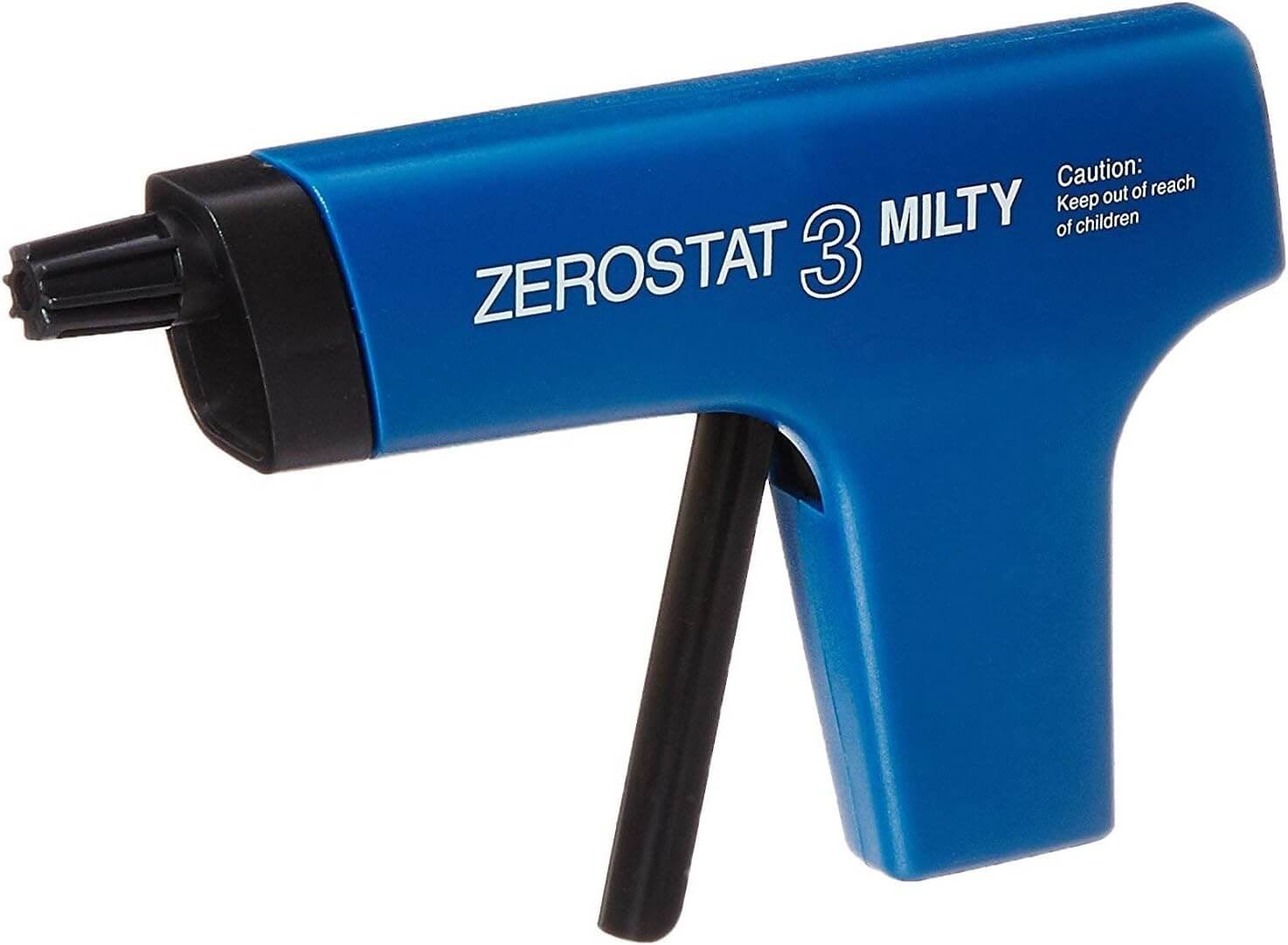Are you hearing pops and crackles while playing your vinyl record?
Well, you’re not alone.
This is a common problem, and the reason behind the pops and crackling sound coming from your record players is static charge.
The static charge is the concept we read about in our science books in our childhood, and almost all of us must have experienced it practically by rubbing the ruler on our hair and seeing this result:

Here, an imbalance of protons and electrons is created when we are rubbing the ruler, due to which static charge builds up.
The same concept applies to vinyl records, too.
In this article, I have explained static charge and how static builds up on vinyl. You will also see the techniques I follow to remove static from vinyl records, along with my vinyl record storage techniques, which help keep my vinyl records static-free.
So, let’s get started and understand the static charge and why it builds up on vinyl.
What is Static Charge or Electricity?
The static charge or electricity is an imbalance of protons (positive charge) and electrons (negative charge).
Every atom has a balance of protons and electrons, i.e., an equal amount of protons and electrons, which makes the material neutrally charged.
If there is any imbalance, i.e., an increase in the number of protons or a decrease in the number of electrons, then the material can be charged positively or negatively, depending on which charge is in excess.
This is the basic understanding you should have about static charge. In case you want to learn more about static electricity, you can read this article.
Well, as you all know, vinyl records are built with PVC (polyvinyl chloride) material, which is a natural insulator, and a static charge is built upon it when it interacts with other objects like record sleeves, hand touches, a stylus running over the record, the temperature and humidity of the room, and much more, and according to my experience, the dry weather builds up the static very fast.
And this static charge can attract dust particles, which can get stuck inside the record grooves and affect the overall vinyl experience. Along with pops and crackles, you could also face record skipping issues.
The natural insulating properties of PVC material are the main reason why you can’t remove static from vinyl permanently.
Understanding the properties of PVC, the manufacturer tried their best to counter this static build-up problem, and now let’s talk about those measures.
Measure Taken By Manufacturers To Reduce Static Charge Of PVC:
The manufacturers added a material called Black Carbon to the original PVC mix to reduce the static charge of the vinyl.
According to Conductive Phonograph Record Patents, black carbon is conductive, so when you mix the black carbon in the PVC mix, then the conductivity is increased, which makes the record less prone to static charge.
Black carbon is the reason why the industry standard color of vinyl is black.
The non-existence of black carbon in colored vinyl is also one of the main reasons why colored vinyl sounded worse in the past. But now, the technology has evolved, and the manufacturers have found a way to make colored vinyl sound as good as black vinyl without black carbon.
After adding black carbon to the PVC mix, the static build is reduced to some extent, but as I said, the black carbon is mixed in the PVC mix, which means the PVC mix is still there so the static build-up issue is still there, and to remove it, we have to follow some techniques at our end.
Now, let’s discuss the static removal and vinyl storage techniques that give me amazing results.
How to Remove Static From Vinyl Records:
Note: If your records are dirty, then I suggest you first clean your records using these methods and then proceed with static charge removal techniques.
Well, I am sharing five methods out of which the first two methods are mandatory to follow, and using the other three is your choice.
So, here are my 100% working methods to keep your records away from static charge:
Method 1: Anti-Static Record Brush:

The anti-static record brushes help a lot in keeping your vinyl static-free. This brush, along with anti-static record inner sleeves, has done wonders for me.
Steps to use this brush:
- Lock the tonearm in its resting place.
- Turn on the turntable and let your record spin.
- Take the brush and put it on the edge of the record. Now, slowly move the brush to the inner side until it touches the spindle.
- Once it touches the spindle, pick up the brush again and repeat the 3rd and 4th steps 4-5 times.
That’s it.
Some people have shared that these brushes built static charge on the records instead of removing it, but it has worked great for me. I am using a Boundless record cleaner brush and recommend that you use the same.
Method 2: Anti-Static Inner Sleeves:

The anti-static record inner sleeves are the best solution to resolve static build-up on records.
I have used these and I have seen a noticeable difference in the sound.
Mostly, we use paper sleeves to store the record, but as I already told you, vinyl records are made from PVC, so they also interact with paper sleeves and air inside, which creates static.
So, what I recommend is that you put the records inside anti-static inner sleeves and then put the records in the paper sleeves. This will solve the problem of static on records.
The sleeves I am currently using are Mobile Fidelity Sound Lab anti-static record sleeves, and I recommend that you get the same.
Method 3: Replace the Felt Mat If Using:
Felt mats are more prone to attract dust, dirt, and static charge. So, if you are using a felt mat, then I recommend you change it to either a cork mat, a leather mat, or an acrylic mat.
Method 4: Anti-Static Gun (Milty Zerostat 3 Anti-Static Gun):

Everyone is recommending having an anti-static gun to remove the static, but most of us don’t know anything about its working concept because you won’t see anything visible coming out of it.
The manufacturer has recommended holding it above the record with a 1-foot distance and then squeezing it and releasing it. That’s it.
Nothing is mentioned in the manual about how it works and how the static is being removed from the vinyl with a gun.
So, I have researched a lot about this gun and figured out its working concept, and now, I am going to explain it to you guys.
How the Milty Zerostat 3 Anti-Static Gun Works:
The working concept of the gun is pure science. The anti-static gun releases positive and negative ions when you use it. The gun spits positive ions when you squeeze the trigger and negative ions when you release it.
These ions go on and interact with the static charge on the vinyl record, which results in removing the static charge completely from the record.
Best Way to Use Milty Zerostat 3 Anti-Static Gun:
1) Remove the record from the turntable and hold it in your hand
2) Hold the record 1 foot away from the gun and slowly squeeze the trigger, and then release it slowly
3) Repeat the second step 4-5 times, and you will see that the static charge is removed magically from the records.
My Experience:
I honestly don’t own this gun right now, but I did some testing with my friend’s gun on my records, and guess what? It works.
But, this gun is a little expensive, so it’s your choice whether you want to invest some bucks to get it or not. You can check more details about the Milty Zerostat 3 Anti-Static Gun here.
Method 5: Walker Audio Talisman:
Walker Audio Talisman is a very old product in the market that is meant for removing static from vinyl, CDs, DVDs, cables, players, and much more.
The size is similar to an anti-static brush, but it contains very strong magnets inside, which help to remove the static from the records.
You need to spin the record on the turntable with the stylus away from the platter. Now, hover the talisman over the record with around a 1 to 1.5-inch gap and spin the record. Keep the talisman hovering on the platter for a few seconds and slide it off the record.
That’s it.
Here is the video demonstration of the tool:
My Experience:
Well, I haven’t used this tool, but I have seen a lot of positive feedback on this. Just like an anti-static gun, this is a little expensive, but if you want to try it, then you can go to your nearby stores and get it.
If you have used this, then please let me know in the comments. Maybe your comment can trigger me to get this one for myself too.
Frequently Asked Questions:
Q1- Why is static bad for vinyl records?
The static buildup on records can attract dust particles that settle down deeper inside the grooves, and these dust particles restrict the stylus from fetching audio signals from the grooves efficiently, which results in sound distortion, crackles, and pops.
Q2- Is it OK to touch a vinyl record?
You should always touch the record from both sides, using both hands. I recommend you avoid touching the grooves because, in that case, the PVC will interact with your hand touches, and a static charge will build up on the record surface.
Q3- Is it normal to hear static on vinyl?
Yes, it is normal to hear static on vinyl, but I recommend you remove static from your records before playing them, otherwise, your vinyl experience will be affected.
So, there are 100% working methods to remove static from vinyl records. If you still have questions then please comment below. We will get back to you as soon as possible.
If you follow any other unique method to remove static, please share it with us, and we will add it to this article.



Hi, I have tried anti-static inner sleeves after reading your article and it is doing wonderful job. Thanks for sharing your experience with us James and yes, I will be implementing your other suggestions too.
Hi Launa, I am glad that my suggestions are working for you.
Anti static record sleeves do help a lot. That’s a very nice suggestion.
Yes Bonny, I have also got amazing results after shifting to anti static sleeves.